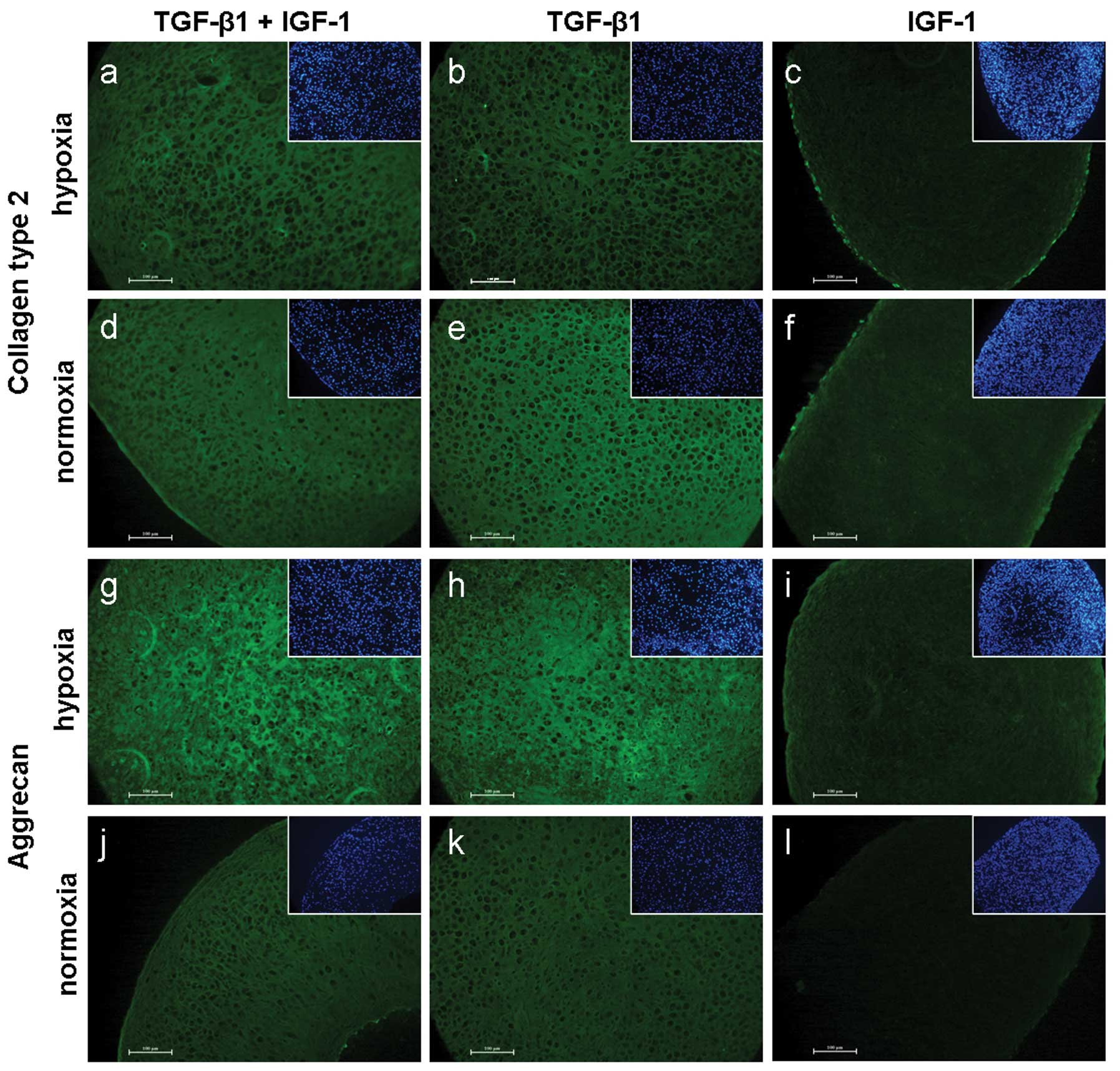|
1.
|
J FarrB ColeA DhawanJ KercherS
ShermanClinical cartilage restoration: evolution and overviewClin
Orthop Relat
Res46926962705201110.1007/s11999-010-1764-z21240578
|
|
2.
|
RF LoeserAging and osteoarthritis: the
role of chondrocyte senescence and aging changes in the cartilage
matrixOsteoarthritis
Cartilage17971979200910.1016/j.joca.2009.03.00219303469
|
|
3.
|
S GiovanniniJ Diaz-RomeroT AignerP HeiniP
Mainil-VarletD NesicMicromass co-culture of human articular
chondrocytes and human bone marrow mesenchymal stem cells to
investigate stable neocartilage tissue formation in vitroEur Cell
Mater202452592010
|
|
4.
|
L PetersonHS VasiliadisM BrittbergA
LindahlAutologous chondrocyte implantation: a long-term follow-upAm
J Sports Med3811171124201010.1177/036354650935791520181804
|
|
5.
|
DG StokesG LiuR DharmavaramD HawkinsS
Piera-VelazquezSA JimenezRegulation of type-II collagen gene
expression during human chondrocyte de-differentiation and recovery
of chondrocyte-specific phenotype in culture involves Sry-type
high-mobility-group box (SOX) transcription factorsBiochem
J360461470200110.1042/0264-6021:3600461
|
|
6.
|
PD BenyaJD ShafferDedifferentiated
chondrocytes reexpress the differentiated collagen phenotype when
cultured in agarose
gelsCell30215224198210.1016/0092-8674(82)90027-77127471
|
|
7.
|
J BonaventureN KadhomL Cohen-SolalKH NgJ
BourguignonC LasselinP FreisingerReexpression of cartilage-specific
genes by dedifferentiated human articular chondrocytes cultured in
alginate beadsExp Cell
Res21297104199410.1006/excr.1994.11238174647
|
|
8.
|
PM van der KraanP BumaKT vanWB van den
BergInteraction of chondrocytes, extracellular matrix and growth
factors: relevance for articular cartilage tissue
engineeringOsteoarthritis Cartilage10631637200212479385
|
|
9.
|
S ChubinskayaA HakimiyanC PacioneA YankeL
RappoportT AignerDC RuegerRF LoeserSynergistic effect of IGF-1 and
OP-1 on matrix formation by normal and OA chondrocytes cultured in
alginate beadsOsteoarthritis
Cartilage15421430200710.1016/j.joca.2006.10.00417126570
|
|
10.
|
P GiannoniR CanceddaArticular chondrocyte
culturing for cell-based cartilage repair: needs and
perspectivesCells Tissues
Organs184115200610.1159/00009694617190975
|
|
11.
|
T FukumotoJW SperlingA SanyalJS
FitzsimmonsGG ReinholzCA ConoverSW O’DriscollCombined effects of
insulin-like growth factor-1 and transforming growth factor-beta1
on periosteal mesenchymal cells during chondrogenesis in
vitroOsteoarthritis
Cartilage115564200310.1053/joca.2002.086912505488
|
|
12.
|
PC YaegerTL MasiJL de OrtizF BinetteR
TuboJM McPhersonSynergistic action of transforming growth
factor-beta and insulin-like growth factor-I induces expression of
type II collagen and aggrecan genes in adult human articular
chondrocytesExp Cell Res237318325199710.1006/excr.1997.3781
|
|
13.
|
GJ van OschSW van der VeenP BumaHL
Verwoerd-VerhoefEffect of transforming growth factor-beta on
proteoglycan synthesis by chondrocytes in relation to
differentiation stage and the presence of pericellular matrixMatrix
Biol1741342419989840443
|
|
14.
|
A JonitzK LochnerK PetersA SalamonJ
PasoldB Mueller-HilkeD HansmannR BaderDifferentiation capacity of
human chondrocytes embedded in alginate matrixConnect Tissue
Res52503511201110.3109/03008207.2011.59367321787134
|
|
15.
|
PA GuerneF BlancoA KaelinA DesgeorgesM
LotzGrowth factor responsiveness of human articular chondrocytes in
aging and developmentArthritis
Rheum38960968199510.1002/art.17803807127612045
|
|
16.
|
L ZhangP SuC XuJ YangW YuD
HuangChondrogenic differentiation of human mesenchymal stem cells:
a comparison between micromass and pellet culture systemsBiotechnol
Lett3213391346201010.1007/s10529-010-0293-x20464452
|
|
17.
|
JE LafontLack of oxygen in articular
cartilage: consequences for chondrocyte biologyInt J Exp
Pathol9199106201010.1111/j.1365-2613.2010.00707.x20384821
|
|
18.
|
J BohenskySP TerkhornTA FreemanCS AdamsJA
GarciaIM ShapiroV SrinivasRegulation of autophagy in human and
murine cartilage: hypoxia-inducible factor 2 suppresses chondrocyte
autophagyArthritis Rheum6014061415200910.1002/art.2444419404942
|
|
19.
|
JA TylerInsulin-like growth factor 1 can
decrease degradation and promote synthesis of proteoglycan in
cartilage exposed to cytokinesBiochem J26054354819892788408
|
|
20.
|
TI MoralesThe insulin-like growth factor
binding proteins in uncultured human cartilage: increases in
insulin-like growth factor binding protein 3 during
osteoarthritisArthritis Rheum4623582367200210.1002/art.10482
|
|
21.
|
D PfanderK GelseHypoxia and
osteoarthritis: how chondrocytes survive hypoxic environmentsCurr
Opin Rheumatol19457462200710.1097/BOR.0b013e3282ba569317762611
|
|
22.
|
E SchipaniPosttranslational modifications
of collagens as targets of hypoxia and Hif-1alpha in endochondral
bone developmentAnn NY Acad
Sci1192317321201010.1111/j.1749-6632.2009.05236.x20392253
|
|
23.
|
E DuvalS LeclercqJM ElissaldeM DemoorP
GaleraK BoumedieneHypoxia-inducible factor 1alpha inhibits the
fibroblast-like markers type I and type II collagen during
hypoxia-induced chondrocyte redifferentiation: hypoxia not only
induces type II collagen and aggrecan, but it also inhibits type I
and type II collagen in the hypoxia-inducible factor
1alpha-dependent redifferentiation of chondrocytesArthritis
Rheum60303830482009
|
|
24.
|
JA MartinBA MillerMB ScherbLA LembkeJA
BuckwalterCo-localization of insulin-like growth factor binding
protein 3 and fibronectin in human articular
cartilageOsteoarthritis
Cartilage10556563200210.1053/joca.2002.079112127836
|
|
25.
|
C GonzalezKG Auw YangJH SchwabJS
FitzsimmonsMM ReinholzZT ReschLK BaleVR ClemensCA ConoverSW
O’DriscollGG ReinholzTransforming growth factor-beta1 modulates
insulin-like growth factor binding protein-4 expression and
proteolysis in cultured periosteal explantsGrowth Horm IGF
Res208186201010.1016/j.ghir.2009.06.00219656700
|














